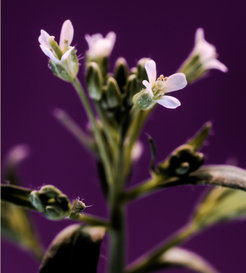Shedding light on a shadow: two transcriptional enhancers control florigen’s response to photoperiod
In many plant species, flowering is controlled by day length through the transcriptional regulation of a key gene called FLOWERING LOCUS T (FT) in the model plant Thale cress (Arabidopsis thaliana). The Turck group at the Max Planck Institute for Plant Breeding Research (Cologne, Germany) has used an epigenetic approach to systematically probe regions surrounding the FT locus for a regulatory role in FT expression. As they now report in Nature Plants (doi 10.1038/s41477-019-0375-2), FT’s response to long days requires the presence of both, a previously characterized distal enhancer located in the promoter and the support of its “shadow” enhancer located downstream of the gene.

FT encodes the florigen, a mobile signal that travels from its site of synthesis in leaves to the shoot tip, where it reprograms the meristem to switch from leaf to flower production. FT expression is tightly controlled at the transcriptional level and requires both a minimum day length and a memory of winter; furthermore, plant age, ambient temperature, and stress can also modulate FT transcription. The Turck group has a long standing interest in understanding the regulatory code of the FT locus.
The regulation of gene expression is linked to the promoter but not only: many genes can have additional regulatory elements called enhancers, which can be located far away from their target gene. Enhancers can physically interact with the promoter of their target genes and boost transcription. DNA methylation is an epigenetic modification which was shown to be associated with the repression of enhancer activity. In plants, it is possible to induce artificially DNA methylation at specific regions using the RNA-dependent DNA methylation (RdDM) pathway. The group used this characteristic of plants to assess the role of candidate regulatory regions of FT. The method was validated by targeting a previously characterized distal enhancer located upstream of the FT promoter and then used to uncover a second enhancer located downstream of the gene.
One novelty of the study resides in the first description in plants of a redundant cis-regulatory element called shadow enhancer. Both regulatory regions promote FT transcription in long days by adding their individual weight to the final transcriptional outcome. “Several examples of shadow enhancers were described in animal models but we don’t think that they are less frequent but just less studied”, says Turck. “Shadow enhancers are interesting from an evolutionary perspective since they may facilitate the integration of novel regulatory information without the risk of critically impairing the primary response, for instance the photoperiod in the case of FT.” Future studies will be directed at comparing both enhancers for common and distinct regulatory responses.
Using the RdDM pathway as discovery tool for regulatory regions adds an interesting toolset to plant research. “Although CRISPR-Cas9 technology can enable us to precisely hit transcription factor binding sites, we do not always know where these are. Induction of DNA methylation on a larger chunk of DNA can be used as fast preliminary step to determine any regulatory role of a specific region”, says first author Johan Zicola. He is also interested in applying the method in crop plants, where knowledge on distal regulatory regions is particularly limited.
The researchers predict that many more regulatory regions participate in gene regulation than anticipated from studies that used isolated regulatory elements and reporter genes. “The second enhancer is called the shadow, because it was overlooked in presence of the first, not necessarily because it is less important in the native chromatin context”, both authors agree.












